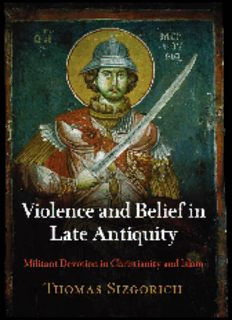
Violence and Belief in Late Antiquity: Militant Devotion in Christianity and Islam PDF
Preview Violence and Belief in Late Antiquity: Militant Devotion in Christianity and Islam
Violence and Belief in Late Antiquity DIVINATIONS: REREADING LATE ANCIENT RELIGION SERIES EDITORS Daniel Boyarin, Virginia Burrus, Derek Krueger A complete list of books in the series is available from the publisher. Violence and Belief in Late Antiquity Militant Devotion in Christianity and Islam Thomas Sizgorich University of Pennsylvania Press Philadelphia Copyright © 2009University of Pennsylvania Press All rights reserved. Except for brief quotations used for purposes of review or scholarly citation, none of this book may be reproduced in any form by any means without written permission from the publisher. Published by University of Pennsylvania Press Philadelphia, Pennsylvania 19104-4112 Printed in the United States of America on acid-free paper 10 9 8 7 6 5 4 3 2 1 Library of Congress Cataloging-in-Publication Data Sizgorich, Thomas. Violence and belief in late antiquity : militant devotion in Christianity and Islam / Thomas Sizgorich. p. cm. — (Divinations: rereading late ancient religion) Includes bibliographical references and index. ISBN 978-0-8122-4113-6(alk. paper) 1. Violence—Religious aspects—Christianity. 2. Violence—Religious aspects—Islam. 3. Martyrdom—Christianity. 4. Martyrdom—Islam. 5. Identity (Psychology)—Religious aspects—Christianity. 6. Identity (Psychology)—Religious aspects—Islam. I. Title. BT736.15.S57 2009 201'.7633209—dc22 2008017407 For N.A.M. and H.A.D. Did I find you, or you find me? This page intentionally left blank CONTENTS INTRODUCTION 1 CHAPTER ONE “The Devil Spoke from Scripture”: Boundary Maintenance and Communal Integrity in Late Antiquity 21 CHAPTER TWO “The Living Voice of Kindred Blood”: Narrative, Identity, and the Primordial Past 46 CHAPTER THREE “What Has the Pious in Common with the Impious?” Ambrose, Libanius, and the Problem of Late Antique Religious Violence 81 CHAPTER FOUR “Are You Christians?” Violence, Ascetics, and Knowing One’s Own 108 CHAPTER FIVE “Horsemen by Day and Monks by Night”: Narrative and Community in Islamic Late Antiquity 144 CHAPTER SIX “The Sword Scrapes Away Transgressions”: Ascetic Praxis and Communal Boundaries in Late Antique Islam 168 CHAPTER SEVEN “Do You Not Fear God?” The Khawa¯rij in Early Islamic Society 196 viii CONTENTS CHAPTER EIGHT “This Is a Very Filthy Question, and No One Should Discuss It”: The Messy World of Ibn H≥anbal 231 CONCLUSION 272 LIST OF ABBREVIATIONS 283 NOTES 285 SELECT BIBLIOGRAPHY 367 INDEX 383 ACKNOWLEDGMENTS 397 INTRODUCTION IN THE NINTH century of the Common Era, the pen of a Christian living in safety very near the heart of Abbasid imperial power scratched out an old and enduring critique of Islam. The Christian, an Iraqi named (cid:1)Amma¯r al-Bas.r¯ı (d. c. 845C.E.), charged that as a religion Islam was illegitimate because it had been spread by the sword, whereas Christianity, the one true system of belief, forbade the use of the sword as a means of promulgation of the faith.1 It is very likely that in issuing this critique (cid:1)Amma¯r was responding to certain Muslim communal narratives concerning the birth and early growth of the Islamic umma. Among the organizing tenets of these narratives was the belief that the first/seventh-century conquests had been a kind of military miracle in which the will of God was manifested in the lightning conquests of the Persian Sasanian Empire and much of the eastern Roman Empire by ragged Arab armies organized around Muh≥ammad’s revelation. As it was put by the author of an anonymous anti-Christian pamphlet, probably written within a century or so of (cid:1)Amma¯r’s death: We set out, barefoot and naked, lacking in every kind of equipment, utterly powerless, deprived in every sort of armament and devoid of all the necessary provisions, to fight the peoples with the most widely extended empires, the peoples that were most manifestly mighty, possessing the most numerous troops, with the most abundant populations and the most imposing domination of the other nations, namely the Persians and the Romans. We went
Description: